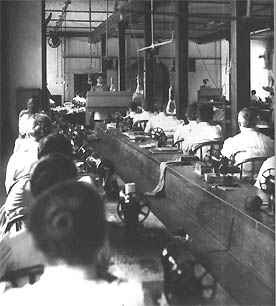Women were received at Auburn Prison from 1825, confined
in a large room in the attic of the south wing. Women were not
exempt from physical punishment. Rachel Welsh arrived at
Auburn Prison January 5, 1825 and died there on January 9, 1826,
six weeks after giving birth to a child clearly conceived in prison.
After a public outcry, a commission of inquiry was appointed to
look into the circumstances of her death. Evidence showed
she had been whipped, frequently and severely. However,
commissioners concluded that "the punishment inflicted
upon Rachel Welsh has no connection with her death."
The first matron ever employed in any New York State
prison was Miss Lucinda Foot, hired by the warden of Auburn
Prison for $16 a month in 1832. As early as 1828, Governor
Clinton had addressed the gross impropriety of females
being confined in quarters connected with a prison for males.
The Legislature authorized the building of women's prisons at
Auburn and at Sing Sing in 1835, but the one at Auburn was
never built. The women's prison at Sing Sing housed all the
state's female convicts until 1877, when they began being housed
in county jails.
 Sewing shop women's prison, c.1915.
Sewing shop women's prison, c.1915.
|
When the asylum for the criminally insane closed
at Auburn in 1894, the state authorized its buildings use as a
prison for women. With 125 rooms, accommodations for as
many as 250 women, the Women's Prison served the entire
state until 1934 when part of the Westfield State Farm at
Bedford Hills became the women's prison.
Thomas Mott Osborne, son of one of
Auburn's most prominent families, was
appointed by Governor Sulzer as Chairman
of a Commission on Prison Reform in 1913.
Osborne wanted to see for himself the
conditions under which convicts lived. He
arranged to go into Auburn Prison "under
cover," entering September 29, 1913 under
the name Tom Brown. He stayed for one
week, living as a regular inmate.
Osborne came away from that week
of incarceration convinced that self
government was the practical remedy of
the problems plaguing the prison system.
He believed that the prison should be
treated as a community, and the prisoners
should have some say in governing that
community. Osborne stressed the value
of educating rather than punishing the
prisoners. He was the driving force behind
the creation of the Mutual Welfare Inmate
League, established at Auburn Prison in
December 1913.
 Thomas Mott Osborne.
Thomas Mott Osborne.
|
Inmates elected delegates to
the League, and the League took over
some of the management of the prison
population, including punishment
of inmates. Some of the humane
improvements that came out of the
Mutual Welfare League were expanded
yard recreation time, weekly movies,
entertainments, an inmate band, and
vocational education programs. The
League also helped establish work
camps, in which well-behaved prisoners
were allowed out of the prison to
work on roads.
The League was successful in
improving the lives of inmates. However,
there was no organized training program
to develop leaders among the prisoners,
and eventually abuses crept into the
system. When the Mutual Welfare League
was blamed by many for the deadly 1929
riots, the League was abolished.



 Sewing shop women's prison, c.1915.
Sewing shop women's prison, c.1915.
 Thomas Mott Osborne.
Thomas Mott Osborne.

